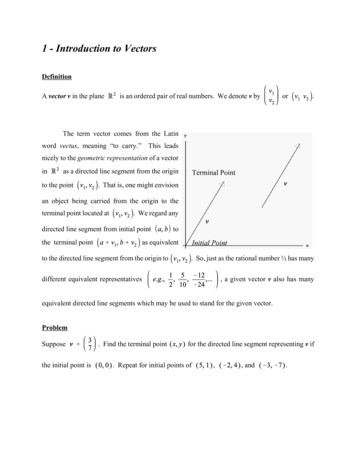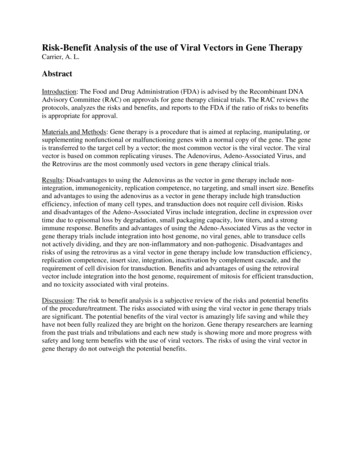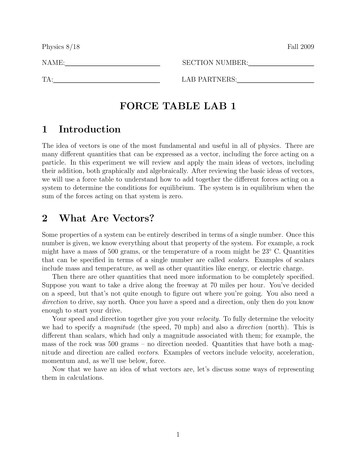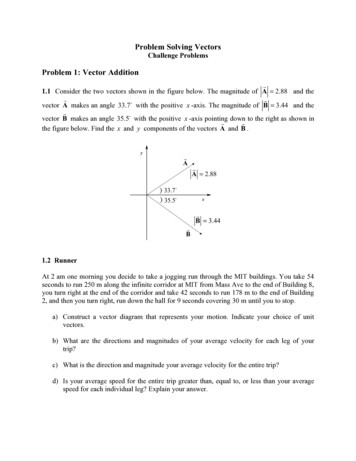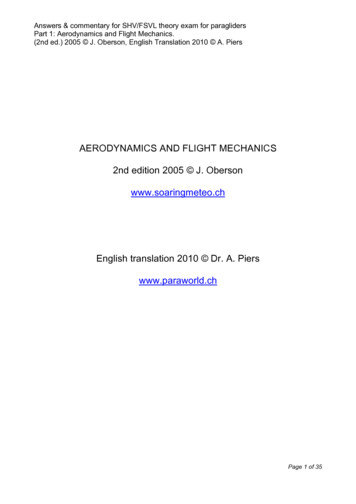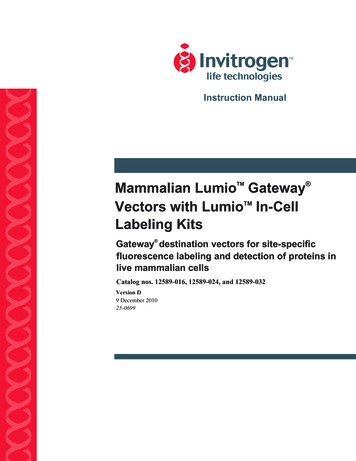
Transcription
Instruction ManualMammalian Lumio Gateway Vectors with LumioTM In-CellLabeling KitsTMGateway destination vectors for site-specificfluorescence labeling and detection of proteins inlive mammalian cellsCatalog nos. 12589-016, 12589-024, and 12589-032Version D9 December 201025-0699
ii
Table of ContentsTable of Contents . . iiiKit Contents and Storage . . vIntroduction . . 1Overview. .1Methods . .4Generating an Entry Clone . .4Creating an Expression Clone . .6Performing the LR Recombination Reaction. .9Transfecting Cells . .12Creating Stable Cell Lines. .14Detecting Lumio Fusion Proteins. .16Appendix. . 18Recipes.18Blasticidin.19Map and Features of pcDNA 6.2/cLumio -DEST . .20Map and Features of pcDNA 6.2/nLumio -DEST . .22Map of pcDNA 6.2/nLumio -GW/p64. .24Technical Service. .25Purchaser Notification . .27Gateway Clone Distribution Policy . .29References .30iii
iv
Kit Contents and StorageTypes of KitsThis manual is supplied with the following products. All products are alsosupplied with the Lumio In-Cell Labeling Kits manual.Product Kit ComponentsCatalog no. Mammalian Lumio Gateway Vectors with LumioGreen In-Cell Labeling Kit12589-016Mammalian Lumio Gateway Vectors with Lumio Red In-Cell Labeling Kit12589-024Mammalian Lumio Gateway Vectors with Lumio Dual Green and Red In-Cell Labeling Kits12589-032The Mammalian Lumio Gateway Vectors with Lumio In-Cell Labeling Kitsinclude the following components. For a detailed description of the contents ofeach component, see the next page.ComponentCatalog no.12589-01612589-02412589-032Mammalian Lumio Gateway Vectors Lumio Green In-Cell Labeling Kit Lumio Red In-Cell Labeling KitShipping andStorageThe Mammalian Lumio Gateway Vectors with Lumio In-Cell Labeling Kits areshipped on blue ice. Upon receipt, store as detailed below.Box Storage Mammalian Lumio Gateway Vectors-20ºC -20ºC, protected from light -20ºC, protected from lightLumio Green In-Cell Labeling KitLumio Red In-Cell Labeling KitLumio Gateway Vectors The Lumio Gateway Vectors are listed below. Store vectors at -20ºC.ItemConcentrationVolume Lyophilized in TE, pH 8.06 µg pcDNA 6.2/nLumio -DESTLyophilized in TE, pH 8.06 µgpcDNA 6.2/nLumio -GW/p64Control PlasmidLyophilized in TE, pH 8.010 µgpcDNA 6.2/cLumio -DESTcontinued on next pagev
Kit Contents and Storage, continuedLumio In-CellLabeling KitsThe Mammalian Lumio Gateway Vectors are supplied with either the Lumio Green, the Lumio Red, or both the Lumio Green and Lumio Red In-CellLabeling Kits. Refer to the Lumio In-Cell Labeling Kits manual for detailedinformation pertaining to each kit and a description of the reagents provided ineach kit.ProductQualificationpcDNA 6.2/cLumio -DEST, pcDNA 6.2/nLumio -DEST, and pcDNA 6.2/nLumio -GW/p64 are qualified by restriction endonuclease digestion. ThepcDNA 6.2/cLumio -DEST and pcDNA 6.2/nLumio -DEST vectors arefurther qualified in a recombination assay using Gateway LR Clonase IIenzyme mix. The ccdB gene is assayed by transformation using an appropriateE. coli strain.For information about how the components of the Lumio In-Cell Labeling Kitsare qualified, refer to the Lumio In-Cell Labeling Kits manual.AccessoryProductsAdditional products that may be used with the Mammalian Lumio Gateway Vectors are available from Invitrogen. Ordering information is provided below.ProductLumio Green In-Cell Labeling Kit Lumio Red In-Cell Labeling Kit Lumio Green Detection Kit BenchMark Fluorescent Protein Standard Gateway LR Clonase II Enzyme Mix One Shot TOP10 Chemically CompetentCells One Shot TOP10 Electrocompetent Cells PureLink HQ Plasmid Purification Kit Lipofectamine 2000BlasticidinviAmountCatalog no.1 kit12589-0571 kit12589-040100 reactionsLC6090100 reactionsLC592820 reactions11791-020100 reactions11791-10010 reactionsC4040-1020 reactionsC4040-0310 reactionsC4040-5020 reactionsC4040-52100 reactionsK2100-011.5 ml11668-0190.75 ml11668-02750 mgR210-01
IntroductionOverviewDescriptionThe Mammalian Lumio Gateway Vector Kits contain Gateway -adapteddestination vectors designed for use with the Lumio Technology. ThepcDNA 6.2/Lumio -DEST vectors supplied with each kit facilitate in vivofluorescence labeling and detection of recombinant proteins when used with aLumio In-Cell Labeling Kit.FeaturesThe pcDNA 6.2/cLumio -DEST and pcDNA 6.2/nLumio -DEST vectorscontain the following elements: Human cytomegalovirus immediate-early (CMV) promoter/enhancer forhigh-level expression in a wide range of mammalian cells Lumio tag for C-terminal (pcDNA 6.2/cLumio -DEST) or N-terminal(pcDNA 6.2/nLumio -DEST) fusion to the gene of interest for fluorescencedetection Two recombination sites, attR1 and attR2, downstream of the CMV promoterfor recombinational cloning of the gene of interest from an entry clone Chloramphenicol resistance gene located between the two attR sites forcounterselection The ccdB gene located between the two attR sites for negative selection The Herpes Simplex Virus thymidine kinase polyadenylation signal forproper termination and processing of the recombinant transcript f1 intergenic region for production of single-strand DNA in F plasmidcontaining E. coli SV40 early promoter and origin for expression of the Blasticidin resistancegene and stable propagation of the plasmid in mammalian hosts expressingthe SV40 large T antigen Blasticidin resistance gene for selection of stable cell lines The pUC origin for high copy replication and maintenance of the plasmid inE. coli The ampicillin resistance gene for selection in E. coliFor a map of pcDNA 6.2/cLumio -DEST and pcDNA 6.2/nLumio -DEST, referto pages 20 and 22, respectively.continued on next page1
Overview, continuedThe Gateway TechnologyThe Gateway Technology is a universal cloning method that takes advantage ofthe site-specific recombination properties of bacteriophage lambda (Landy, 1989)to provide a rapid and highly efficient way to move your gene of interest intomultiple vector systems. To express your gene of interest in mammalian cellsusing Gateway Technology, simply:1. Clone your gene of interest into a Gateway entry vector to create an entryclone.2. Generate an expression clone by performing an LR recombination reactionbetween the entry clone and a Gateway destination vector (e.g. pcDNA 6.2/cLumio -DEST or pcDNA 6.2/nLumio -DEST).3. Transfect your expression clone into the cell line of choice for transient orstable expression of your gene of interest.For more information on Gateway , refer to the Gateway Technology withClonase II manual. This manual is available for downloading from our Web site(www.invitrogen.com) or by contacting Technical Service (page 25).Advantages of theLumio TechnologyThe Lumio System is based on the FlAsH (Fluorescein Arsenical Hairpin)technology which uses biarsenical labeling reagents to bind and detect proteinscontaining a tetracysteine motif (i.e. Lumio tag) (Griffin et al., 1998). Using theLumio Technology and the Lumio In-Cell Labeling Kits for fluorescencelabeling of recombinant proteins provides the following advantages: Small size of the Lumio tag (6 amino acids, 585 Da) is less likely to interferewith the structure or biological activity of the protein of interest Lumio Labeling Reagents are membrane-permeable and readily cross thecell membrane, allowing labeling and detection of recombinant proteins inlive mammalian cells Lumio Labeling Reagents bind the Lumio tag with high specificity andhigh affinity (nanomolar or lower dissociation constant), allowing targetedlabeling of the protein of interest Lumio Labeling Reagents become strongly fluorescent only upon bindingthe Lumio tag, allowing specific detection of Lumio -tagged proteinscontinued on next page2
Overview, continuedComponents ofthe Lumio SystemThe Lumio System consists of two major components: The tetracysteine Lumio tag (Cys-Cys-Pro-Gly-Cys-Cys) in the pcDNA 6.2/Lumio -DEST vector. When fused to a gene of interest, the Lumio tag allowsthe expressed fusion protein to be specifically recognized by a biarsenicallabeling reagent. For more information on the tetracysteine motif, see below. A biarsenical labeling reagent, Lumio Green or Lumio Red, which becomesfluorescent upon binding to recombinant proteins containing the Lumio tag.The Lumio Green and Lumio Red Labeling Reagents are supplied precomplexed to the dithiol EDT (1,2-ethanedithiol) which stabilizes andsolubilizes the biarsenic reagents.TetracysteineMotifThe Lumio Reagents bind a tetracysteine motif consisting of Cys-Cys-Xaa-XaaCys-Cys where Cys equals cysteine and Xaa equals any amino acid other thancysteine. This motif is rarely seen in naturally occurring proteins allowing specificfluorescence labeling of recombinant proteins fused to the Lumio tag. In theLumio System, the optimized Cys-Cys-Pro-Gly-Cys-Cys tetracysteine motif isused as this motif has been shown to have a higher affinity for and more rapidbinding to biarsenic compounds as well as enhanced stability compared to othercharacterized motifs (Adams et al., 2002).Lumio GreenDetection KitFor sensitive and specific in-gel detection of Lumio -tagged fusion proteins, werecommend the Lumio Green Detection Kit available from Invitrogen (Catalogno. LC6090). The Lumio Green Detection Kit enables immediate visualization ofLumio -tagged proteins in polyacrylamide gels using a UV transilluminator or avisible light laser-based scanner and without the need for staining or westernblotting. In addition, the BenchMark Fluorescent Protein Standard (Catalog no.LC5928) allows you to easily visualize molecular weight ranges of proteins labeledwith Lumio Green Detection Reagent. For more information on these productsand other products that may be used with the Lumio Technology, visit our Website (www.invitrogen.com) or contact Technical Service (page 25).3
MethodsGenerating an Entry CloneIntroductionTo recombine your gene of interest into pcDNA 6.2/cLumio -DEST orpcDNA 6.2/nLumio -DEST, you will need an entry clone containing the gene ofinterest. Many entry vectors including pENTR/D-TOPO (Catalog no. K2400-20)are available from Invitrogen to facilitate generation of entry clones. For moreinformation, refer to our Web site (www.invitrogen.com) or contact TechnicalService (page 25). Refer to the manual for the specific entry vector you are usingfor detailed instructions to construct an entry clone.Tag-On-Demand SystemThe pcDNA 6.2/cLumio -DEST vector is compatible with the Tag-OnDemand System which allows expression of both native and C-terminallytagged recombinant protein from the same expression construct.The System is based on stop suppression technology originally developed byRajBhandary and colleagues (Capone et al., 1985) and consists of a recombinantadenovirus expressing a tRNAser suppressor. When an expression vectorencoding a gene of interest with the TAG (amber stop) codon is transfected intomammalian cells, the stop codon will be translated as serine, allowingtranslation to continue and resulting in production of a C-terminally-taggedfusion protein.For more information, refer to the Tag-On-Demand Suppressor Supernatantmanual. This manual is available for downloading from our Web site(www.invitrogen.com) or contact Technical Service (page 25).If you wish to express a human or mouse gene of interest, we recommend usingan Ultimate Human ORF (hORF) or Ultimate Mouse ORF (mORF) Cloneavailable from Invitrogen. Each Ultimate ORF Clone is a fully sequenced cloneprovided in a Gateway entry vector that is ready-to-use in an LR recombinationreaction with pcDNA 6.2/cLumio -DEST. In addition, each clone contains aTAG stop codon, making it fully compatible for use in the Tag-On-Demand System. For more information about the Ultimate ORF Clones available, refer toour Web site (www.invitrogen.com) or contact Technical Service (page 25).Kozak ConsensusSequenceIf you will be expressing your protein from pcDNA 6.2/cLumio -DEST, yourinsert in the entry clone should contain a Kozak translation initiation sequencewith an ATG initiation codon for proper initiation of translation (Kozak, 1987;Kozak, 1991; Kozak, 1990). An example of a Kozak consensus sequence isprovided below. The ATG initiation codon is shown underlined.(G/A)NNATGGOther sequences are possible, but the G or A at position -3 and the G at position 4 are the most critical for function (shown in bold).continued on next page4
Generating an Entry Clone, continuedPoints to Consider pcDNA 6.2/cLumio -DEST allows expression of recombinant proteins with aC-terminal peptide containing the V5 epitope and the Lumio tag; however, youfor pcDNA 6.2/ may use this vector to express a native protein, if desired. You may also use thiscLumio -DESTvector in the Tag-On-Demand System (see previous page). Consider thefollowing when generating your entry clone.If you wish to.include the V5 epitope andLumio tagThen your insert. should contain a Kozak initiationsequence (see previous page) should not contain a stop codon should be in frame with the V5 epitopeand Lumio tag after recombination (seepage 7 for a diagram)include the V5 epitope andLumio tag for use in the TagOn-Demand System should contain a Kozak initiationsequence (see previous page) should contain a TAG stop codon should be in frame with the V5 epitopeand Lumio tag after recombination (seepage 7 for a diagram)not include the V5 epitope andLumio tag should contain a Kozak initiationsequence (see previous page) should contain a stop codonPoints to Consider pcDNA 6.2/nLumio -DEST allows expression of recombinant proteins with anN-terminal peptide containing the Lumio and V5 epitope tags and contains anfor pcDNA 6.2/ATG initiation codon within the context of a Kozak consensus sequence (seenLumio -DESTprevious page). To include the Lumio and V5 epitope tags, your insert in theentry clone should: not contain a Kozak initiation sequence be in frame with the Lumio and V5 epitope tags after recombination (seepage 8 for a diagram) contain a stop codon5
Creating an Expression CloneIntroductionAfter you have generated an entry clone, you will perform the LR recombinationreaction to transfer the gene of interest into your pcDNA 6.2/Lumio -DESTvector to create your expression clone. To ensure that you obtain the best possibleresults, we recommend that you read this section and the next section entitledPerforming the LR Recombination Reaction (pages 9-11) before beginning.ExperimentalOutlineTo generate an expression clone, you will:1.Perform an LR recombination reaction using the attL-containing entry cloneand the attR-containing pcDNA 6.2/Lumio -DEST vector.2.Transform the reaction mixture into a suitable E. coli host.3.Select for expression clones (refer to pages 7-8 for diagrams of therecombination region of the resulting expression clones).Resuspending theVectorsThe pcDNA 6.2/Lumio -DEST vectors are supplied as 6 µg of plasmid,lyophilized in TE, pH 8.0. To use, simply resuspend the destination vector in40 µl of sterile water to a final concentration of 150 ng/µl.Propagating theVectorsIf you wish to propagate and maintain the pcDNA 6.2/Lumio -DEST vectors,we recommend using One Shot ccdB Survival T1R Chemically Competent E. coli(Catalog no. C7510-03) from Invitrogen for transformation. The ccdB Survival T1RE. coli strain is resistant to CcdB effects and can support the propagation ofplasmids containing the ccdB gene. To maintain the integrity of the vector, selectfor transformants in media containing 50-100 µg/ml ampicillin and 15-30 µg/mlchloramphenicol.Note: Do not use general E. coli cloning strains including TOP10 or DH5α for propagationand maintenance of the pcDNA 6.2/Lumio -DEST vectors as these strains are sensitive toCcdB effects.continued on next page6
Creating an Expression Clone, continuedRecombinationRegion forpcDNA 6.2/cLumio -DESTThe recombination region of the expression clone resulting from pcDNA 6.2/cLumio -DEST entry clone is shown below.Note: If you are using pcDNA 6.2/cLumio -DEST in the Tag-On-Demand System, yourgene of interest must contain a TAG stop codon (see page 4 for more information).Features of the Recombination Region: Shaded regions correspond to DNA sequences transferred from the entryclone into pcDNA 6.2/cLumio -DEST by recombination. Non-shadedregions are derived from the pcDNA 6.2/cLumio -DEST vector. Bases 922 and 2605 of the pcDNA 6.2/cLumio -DEST vector sequence aremarked.TATACAAT3 end of CMV promoterPutativetranscriptional start771 CAAATGGGCG GTAGGCGTGT ACGGTGGGAG GTCTATATAA GCAGAGCTCT CTGGCTAACTT7 promoter/priming site831 AGAGAACCCA CTGCTTACTG GCTTATCGAA ATTAATACGA CTCACTATAG GGAGACCCAA922attB1891 GCTGGCTAGT TAAGCTGAGC ATCAACAAGT TTGTACAAAA AAGCAGGCTNTAGTTGTTCA AACATGTTTT TTCGTCCGAN2605GENENACNTGattB22597 CCA GCT TTC TTG TAC AAA GTG GTT GAT GCT GTT AAC GGG AAG CCT ATCGGT CGA AAG AAC ATG TTT CAC CAA CTA CGA CAA TTG CCC TTC GGA TAGPro Ala Phe Leu Tyr Lys Val Val Asp Ala Val Asn Gly Lys Pro IleV5 epitope2645 CCT AAC CCT CTC CTC GGT CTC GAT TCT ACG CGT ACC GGT GCT GGT GGCGGA TTG GGA GAG GAG CCA GAG CTA AGA TGC GCA TGG CCA CGA CCA CCGPro Asn Pro Leu Leu Gly Leu Asp Ser Thr Arg Thr Gly Ala Gly GlyLumio tag2693 TGT TGT CCT GGC TGT TGC GGT GGC GGC TAG TAA TGA GTTTAAACGGACA ACA GGA CCG ACA ACG CCA CCG CCG ATC ATT ACTCys Cys Pro Gly Cys Cys Gly Gly Gly *** *** ***TK polyA Reverse priming site2739 GGGAGGCTAA CTGAAACACG GAAGGAGACA ATACCGGAAG GAACCCGCGC TATGACGGCAcontinued on next page7
Creating an Expression Clone, continuedRecombinationRegion forpcDNA 6.2/nLumio -DESTThe recombination region of the expression clone resulting from pcDNA 6.2/nLumio -DEST entry clone is shown below.Features of the Recombination Region: Shaded regions correspond to DNA sequences transferred from the entryclone into pcDNA 6.2/nLumio -DEST by recombination. Non-shadedregions are derived from the pcDNA 6.2/nLumio -DEST vector. Bases 1018 and 2680 of the pcDNA 6.2/nLumio -DEST vector sequence aremarked.CAATTATA3 end of CMV promoterPutativetranscriptional start771 CAAATGGGCG GTAGGCGTGT ACGGTGGGAG GTCTATATAA GCAGAGCTCT CTGGCTAACTT7 promoter/priming site831 AGAGAACCCA CTGCTTACTG GCTTATCGAA ATTAATACGA CTCACTATAG GGAGACCCAALumio tag891 GCTGGCTAGT TAAGCTGCACC ATG GCT GGT GGC TGT TGT CCT GGC TGT TGC GGTTAC CGA CCA CCG ACA ACA GGA CCG ACA ACG CCAMet Ala Gly Gly Cys Cys Pro Gly Cys Cys GlyV5 epitope945 GGC GGC AAG CTG GGT AAG CCT ATC CCT AAC CCT CTC CTC GGT CTC GAT TCTCCG CCG TTC GAC CCC TTC GGA TAG GGA TTG GGA GAG GAG CCA GAG CTA AGAGly Gly Lys Leu Gly Lys Pro Ile Pro Asn Pro Leu Leu Gly Leu Asp Ser1018attB1996 ACG AGT GCT GTT ATC ACA AGT TTG TAC AAA AAA GCA GGC TNNTGC TCA CGA CAA TAG TGT TCA AAC ATG TTT TTT CGT CCG ANN GENEThr Ser Ala Val Ile Thr Ser Leu Tyr Lys Lys Ala Gly . . . ***2680attB22670 ACCCAGCTTT CTTGTACAAA GTGGTGATAA CACCGGTTAG TAATGAGTTT AAACGGGGGATGGGTCGAAA GAACATGTTT CACCACTATTTK polyA Reverse priming site2730 GGCTAACTGA AACACGGAAG GAGACAATAC CGGAAGGAAC CCGCGCTATG ACGGCAATAA8
Performing the LR Recombination ReactionIntroductionOnce you have obtained an entry clone containing your gene of interest, you mayperform an LR recombination reaction between the entry clone and yourpcDNA 6.2/Lumio -DEST vector, and transform the reaction mixture into asuitable E. coli host (see below) to select for an expression clone. We recommendincluding the pENTR -gus positive control supplied with the LR Clonase IIenzyme mix in your experiments to help you evaluate your results.E. coli HostYou may use any recA, endA E. coli strain including TOP10, DH5α , or equivalentfor transformation. Do not transform the LR reaction mixture into E. coli strainsthat contain the F′ episome (e.g. TOP10F′). These strains contain the ccdA geneand will prevent negative selection with the ccdB gene.The presence of the EM7 promoter and the Blasticidin resistance gene in thepcDNA 6.2/Lumio -DEST vectors allows for selection of E. coli transformantsusing Blasticidin. For selection, use Low Salt LB agar plates containing 100 µg/mlBlasticidin (see the Appendix, page 18 for a recipe). For Blasticidin to be active,the salt concentration of the medium must remain low ( 90 mM) and the pHmust be 7.0.Blasticidin is available separately from Invitrogen (see page vi for orderinginformation). Refer to the Appendix, page 19 for instructions on how to prepareand store Blasticidin.LR Clonase IIEnzyme MixLR Clonase II enzyme mix is available separately from Invitrogen (Catalog no.11791-020) to catalyze the LR recombination reaction. The LR Clonase II enzymemix combines the proprietary enzyme formulation and 5X LR Clonase ReactionBuffer previously supplied as separate components in LR Clonase enzyme mixinto an optimized single-tube format for easier set-up of the LR recombinationreaction. Use the protocol provided on page 10 to perform the LR recombinationreaction using LR Clonase II enzyme mix.Note: You may perform the LR recombination reaction using LR Clonase enzyme mix, ifdesired. To use LR Clonase enzyme mix, follow the protocol provided with the product.Do not use the protocol for LR Clonase II enzyme mix provided in this manual as reactionconditions differ.continued on next page9
Performing the LR Recombination Reaction, continuedMaterials NeededSetting Up the LRRecombinationReactionYou should have the following materials on hand before beginning: Purified plasmid DNA of your entry clone (50-150 ng/µl in TE, pH 8.0) pcDNA 6.2/cLumio -DEST or pcDNA 6.2/nLumio -DEST vector(150 ng/µl in TE, pH 8.0) LR Clonase II enzyme mix (Invitrogen, Catalog no. 11791-020; keep at -20 Cuntil immediately before use) pENTR -gus positive control, optional (50 ng/µl in TE, pH 8.0; supplied withthe LR Clonase II enzyme mix) TE Buffer, pH 8.0 (10 mM Tris-HCl, pH 8.0, 1 mM EDTA) 2 µg/µl Proteinase K solution (supplied with the LR Clonase II enzyme mix;thaw and keep on ice until use) Appropriate competent E. coli host and growth media for expression S.O.C. Medium LB agar plates with the appropriate antibiotic to select for expression clones1.Add the following components to 1.5 ml microcentrifuge tubes at roomtemperature and mix.Note: To include a negative control, set up a second sample reaction and substituteTE Buffer, pH 8.0 for the LR Clonase II enzyme mix (see Step 4).ComponentSamplePositive ControlEntry clone (50-150 ng/reaction)1-7 µl--Destination vector (150 ng/µl)1 µl1 µlpENTR -gus (50 ng/µl)--2 µlTE Buffer, pH 8.0to 8 µl5 µl 2.Remove the LR Clonase II enzyme mix from -20 C and thaw on ice( 2 minutes).3.Vortex the LR Clonase II enzyme mix briefly twice (2 seconds each time).4.To each sample above, add 2 µl of LR Clonase II enzyme mix. Mix well bypipetting up and down.Reminder: Return LR Clonase II enzyme mix to -20 C immediately after use.5.Incubate reactions at 25 C for 1 hour.Note: Extending the incubation time to 18 hours typically yields more colonies.6.Add 1 µl of the Proteinase K solution to each reaction. Incubate for10 minutes at 37 C.7.Transform 1 µl of the LR recombination reaction into a suitable E. coli host(follow the manufacturer’s instructions) and select for expression clones.Note: You may store the LR reaction at -20 C for up to 1 week before transformation.continued on next page10
Performing the LR Recombination Reaction, continuedWhat You ShouldSeeIf you use E. coli cells with a transformation efficiency of 1 x 108 cfu/µg, the LRreaction should give 5000 colonies if the entire reaction is transformed andplated.Confirming theExpression CloneThe ccdB gene mutates at a very low frequency, resulting in a very low numberof false positives. True expression clones will be ampicillin-resistant andchloramphenicol-sensitive. Transformants containing a plasmid with a mutatedccdB gene will be both ampicillin- and chloramphenicol-resistant. To check yourputative expression clone, test for growth on LB plates containing 30 µg/mlchloramphenicol. A true expression clone will not grow in the presence ofchloramphenicol.SequencingYou may sequence your construct to confirm that your gene is in frame with theappropriate N-terminal or C-terminal fusion tag, if desired. We suggest using theT7 Promoter and TK polyA Reverse primer sequences (see below). Refer to thediagram on page 7 or page 8 for the location of the primer binding sites.PrimerSequenceT7 Promoter Primer5 -TAATACGACTCACTATAGGG-3 TK polyA Reverse Primer5 -CTTCCGTGTTTCAGTTAGC-3 11
Transfecting CellsIntroductionThis section provides general information for transfecting your expression cloneinto the mammalian cell line of choice. We recommend that you include thepcDNA 6.2/nLumio -GW/p64 positive control vector and a non-Lumio control in your transfection experiment to help you evaluate your results. Thenon-Lumio control should contain cells transfected with a vector that does notencode the Lumio tag. Using untransfected cells (no transfection reagent, noDNA) as a control is not optimal since transfection may introduce fluorescentartifacts or alter cell morphology that could affect the labeling and detection ofyour protein.PlasmidPreparationOnce you have generated your expression clone, you must isolate plasmid DNAfor transfection. Plasmid DNA for transfection into eukaryotic cells must be cleanand free from contamination with phenol and sodium chloride. Contaminantswill kill the cells, and salt will interfere with lipid complexing, decreasingtransfection efficiency. We recommend isolating plasmid DNA using thePureLink HQ Mini Plasmid Purification Kit (Catalog no. K2100-01). Otherplasmid purification kits or methods are suitable.Methods ofTransfectionFor established cell lines (e.g. HeLa), consult original references or the supplier ofyour cell line for the optimal method of transfection. We recommend that youpay particular attention to medium requirements, when to pass the cells, and atwhat dilution to split the cells. Further information is provided in CurrentProtocols in Molecular Biology (Ausubel et al., 1994).Methods for transfection include calcium phosphate (Chen and Okayama, 1987;Wigler et al., 1977), lipid-mediated (Felgner et al., 1989; Felgner and Ringold,1989) and electroporation (Chu et al., 1987; Shigekawa and Dower, 1988). Forhigh efficiency transfection in a broad range of mammalian cell lines, werecommend using Lipofectamine 2000 Reagent (Catalog no. 11668-027)available from Invitrogen. For more information about Lipofectamine 2000 andthe other transfection reagents available from Invitrogen, refer to our Web site(www.invitrogen.com) or contact Technical Service (page 25).Cell DensityIf you plan to label your recombinant protein using the Lumio In-Cell LabelingKit, we recommend designing your transfection experiment so that cells will be atoptimal density at the time of labeling. Suspension cells typically label mostefficiently at a density of 1-2 x 106 cells/ml. Adherent cells label most efficientlywhen they are 60-90% confluent at the time of labeling.continued on next page12
Transfecting Cells, continuedPositive ControlpcDNA 6.2/nLumio -GW/p64 is provided as a positive control vector formammalian cell transfection and expression (see page 24 for a map) and may beused to optimize recombinant protein expression levels in your cell line. Thisvector allows ex
vi Kit Contents and Storage, continued Lumio In-Cell Labeling Kits The Mammalian Lumio Gateway Vectors are supplied with either the Lumio Green, the Lumio Red, or both the Lumio Green and Lumio Red In-Cell Labeling Kits. Refer to the Lumio In-Cell Labeling Kits manual for detailed information pertaining to each kit and a description of the reagents provided in
